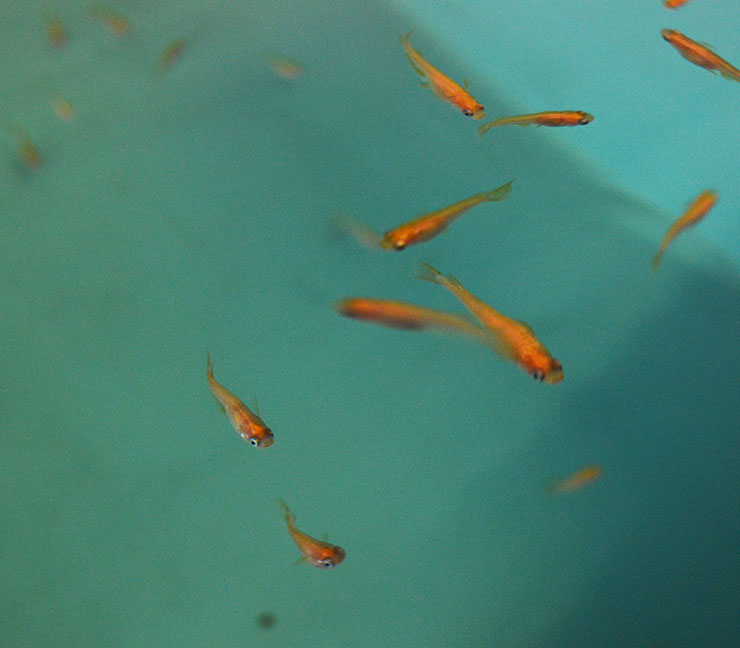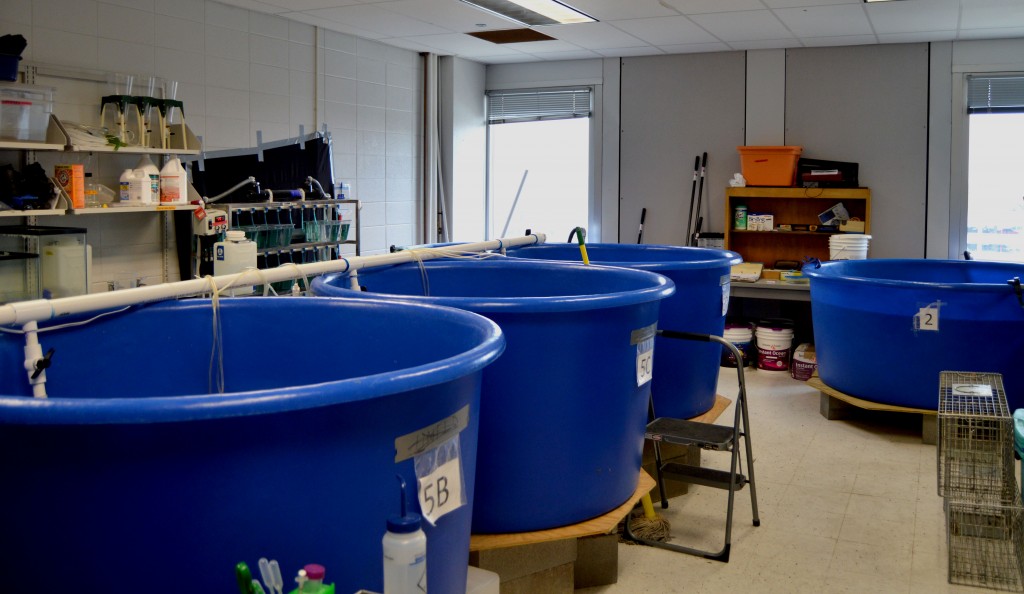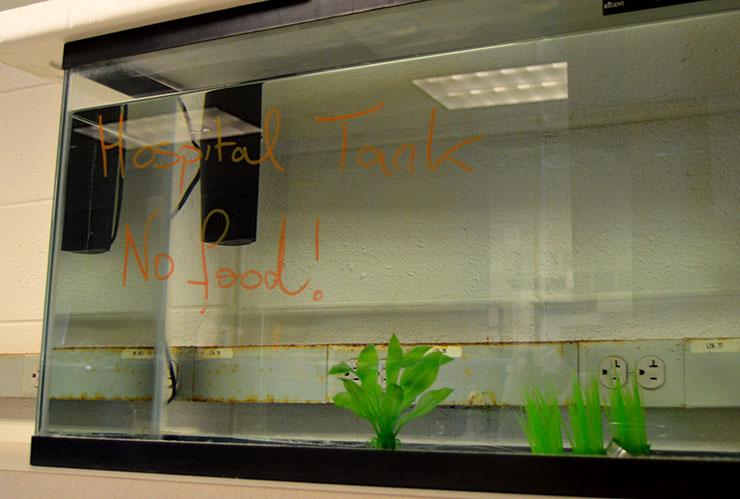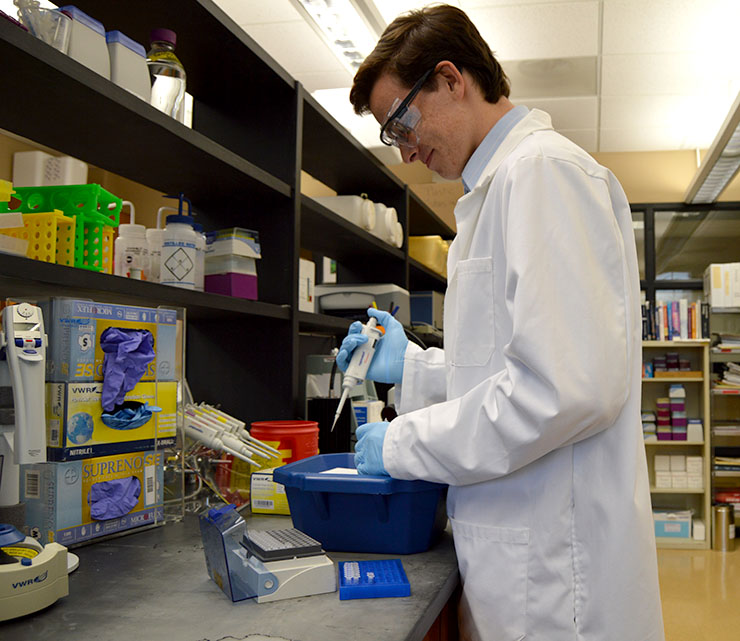Honors student: Justin Reed, senior biochemistry and biology major
Faculty mentor: Christian Tipsmark, assistant professor of biological sciences
Overview:
Schools of tiny fish originally from the coastal rice paddies of Southeast Asia may seem a little out of place in Arkansas, but in Christian Tipsmark’s lab they are prized for a rare trait. Honors College student Justin Reed has joined Dr. Tipsmark’s research on the Japanese medaka, which are classified as euryhaline because of their ability to adapt to both salt water and fresh water. In the lab, they investigate the relationship between the endocrine system and salt transport in the gill, which allows the fish to maintain water and salt balance in their bodies.

Medaka swim in one of the many tanks in the fish lab. They’re very small – about the size of a guppy.
Research questions:
Are the mechanisms needed to maintain constant blood salt levels in both salt and fresh water the same in medaka and another euryhaline fish, rainbow trout? Or are the mechanisms different, which would indicate convergent evolution (i.e. the development of similar traits without inheriting it from a common ancestor).
Findings:
“What we’ve found is that it’s not exactly the same – the medaka and rainbow trout use different strategies,” Justin said. These findings are very exciting but not entirely surprising to Dr. Tipsmark. “We know that the ability to osmoregulate in fresh water may have developed several times during evolution,” Dr. Tipsmark said. “So it seems that different fishes have slightly different strategies to cope with the same types of problems.”
Why it matters:
Dr. Tipsmark has a favorite analogy to describe the gill surface epithelia and their barrier function. First, he asks that you imagine a six-pack of soda cans. The cans are the cells. The plastic between the cans, the ‘tight junctions,’ separate the environmental solution from the internal compartment bathed in blood. Many of the same proteins found in the tight junctions of gill cells are also found in epithelial tissue lining the human body, as in the skin, airways, and digestive tract, and a lot of the same general principles apply. Therefore, Justin’s research on tissue transitions in euryhaline medaka may contribute to a better understanding of kidney disease, Crohn’s disease and some cancers (80 to 90 percent of all cancer cases starts in epithelial tissue). “It’s crucial to understand how these cells interact, maintain barrier function, and communicate,” Dr. Tipsmark said. Since medaka acclimate to varying levels of salinity very quickly, they are ideal for use in studying this at the cellular level. “Things that change fast, give you a tremendous advantage if you want to understand their function,” Dr. Tipsmark said.
Challenges:
Justin faced a series of challenges with the in vivo experiments (experiments tested on whole, living organisms). He used growth hormone from sheep to measure their effect on protein expression in the medaka. “I was having trouble getting consistent data, so we had to change our methods,” Justin said. During a six-month time frame, only one of three in vivo experiments was successful. Then over the summer, Justin and Dr. Tipsmark combined their trouble-shooting efforts and switched to in vitro experiments (those tested at the cellular level), which proved to be more effective.
“I’m very impressed with Justin’s perseverance, a key hallmark for success. He works diligently even after his initial setbacks. He works hard by investigating scientific and technical problems on his own. Meanwhile, he is not afraid to ask questions when barriers arise. In research, these are very important skills, because you otherwise risk wasting time, emotional energy and expensive chemical supplies.” Dr. Tipsmark said.
Achievements:
Justin received honorable mention for his oral presentation of his research at the IDeA Network of Biomedical Research Excellence regional conference in November. He was one of six biological science students to give an oral presentation and the only student from the University of Arkansas. Justin hopes to publish his work, and conference experience aids that effort.
How has research shaped your long-term goals?
“While medicine and science have always been close to my heart, I was initially unsure how much research should be a part of my career,” Justin said. Working with Dr. Tipsmark along with shadowing medical professionals has inspired Justin to pursue an M.D.–Ph.D. after he graduates. The M.D.–Ph.D. program will allow him to pursue both goals because he would be trained as a “physician/scientist who can relate research to medical practice.”




